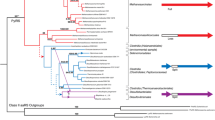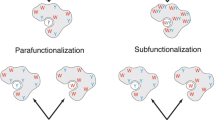Abstract.
In translation, separate aminoacyl-tRNA synthetases attach the 20 different amino acids to their cognate tRNAs, with the exception of glutamine. Eukaryotes and some bacteria employ a specific glutaminyl-tRNA synthetase (GlnRS) which other Bacteria, the Archaea (archaebacteria), and organelles apparently lack. Instead, tRNAGln is initially acylated with glutamate by glutamyl-tRNA synthetase (GluRS), then the glutamate moiety is transamidated to glutamine. Lamour et al. [(1994) Proc Natl Acad Sci USA 91:8670–8674] suggested that an early duplication of the GluRS gene in eukaryotes gave rise to the gene for GlnRS—a copy of which was subsequently transferred to proteobacteria. However, questions remain about the occurrence of GlnRS genes among the Eucarya (eukaryotes) outside of the ``crown'' taxa (animals, fungi, and plants), the distribution of GlnRS genes in the Bacteria, and their evolutionary relationships to genes from the Archaea. Here, we show that GlnRS occurs in the most deeply branching eukaryotes and that putative GluRS genes from the Archaea are more closely related to GlnRS and GluRS genes of the Eucarya than to those of Bacteria. There is still no evidence for the existence of GlnRS in the Archaea. We propose that the last common ancestor to contemporary cells, or cenancestor, used transamidation to synthesize Gln-tRNAGln and that both the Bacteria and the Archaea retained this pathway, while eukaryotes developed a specific GlnRS gene through the duplication of an existing GluRS gene. In the Bacteria, GlnRS genes have been identified in a total of 10 species from three highly diverse taxonomic groups: Thermus/Deinococcus, Proteobacteria γ/β subdivision, and Bacteroides/Cytophaga/Flexibacter. Although all bacterial GlnRS form a monophyletic group, the broad phyletic distribution of this tRNA synthetase suggests that multiple gene transfers from eukaryotes to bacteria occurred shortly after the Archaea–eukaryote divergence.
Similar content being viewed by others
Author information
Authors and Affiliations
Rights and permissions
About this article
Cite this article
Brown, J., Doolittle, W. Gene Descent, Duplication, and Horizontal Transfer in the Evolution of Glutamyl- and Glutaminyl-tRNA Synthetases. J Mol Evol 49, 485–495 (1999). https://doi.org/10.1007/PL00006571
Issue Date:
DOI: https://doi.org/10.1007/PL00006571




